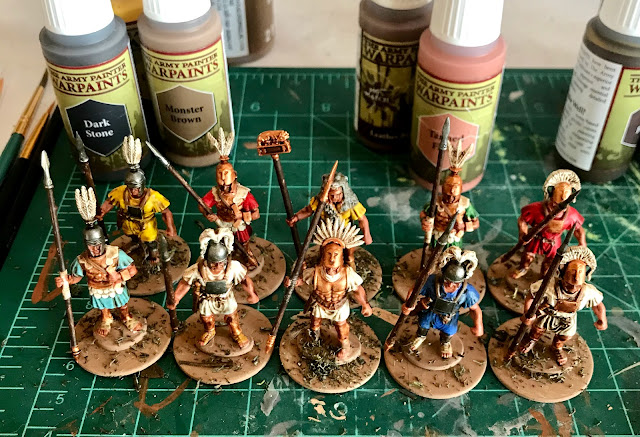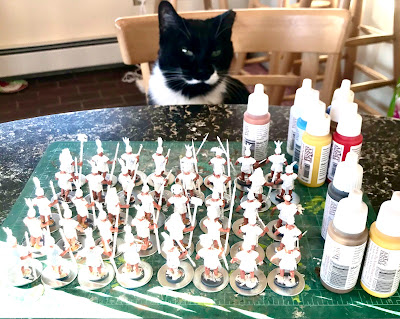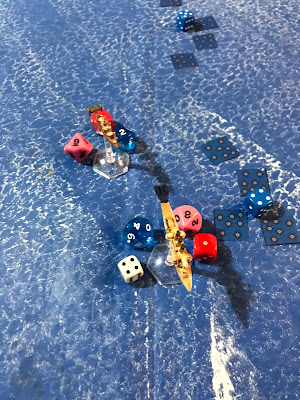By 1901, the British had established a colony in the Gold Coast after fighting a number of wars against the indigenous Ashanti/Asante peoples. The British had built a number of railways across the region in order to transport gold and other resources to the coast for export to Britain. This proved to be a lucrative trade route.
At this point, West Africa had been gobbled up by a number of European colonial powers including the Portuguese, Belgians, Germans, and the French. That made control of the air and sea lanes from West Africa back to their colonial overseers a matter of National importance. It was in such regions that Great Power politics tended to rear their head.
Mission:
Again, we used the random scenario and complication generator to determine today's mission. We rolled up the Convoy Raid scenario. The British were determine to be the defenders, while the French were going to be the Attackers.
The Complications table determined that Cloud Cover was going to be in effect. At Altitude 7, and clouds covered the entire board. That means shots in, out and through the cloud bank can not be made. You can only target ships at Altitude 7 if you are also at Altitude 7 and short range.
Forces:
L'Aire National
Pascal- Commodore Murat
-1 Descartes Cruiser- Command 2
Tangiers- Captain Guy-Victor
-1 D'iberville Cruiser- Command 3
Casablanca- Captain Bayard
-1 Chasseur Destroyer- Command 1
Durandal- Captain Valjean
-1 Voltiguer Destroyer- Command 3
Arc- Captain Danjou
-1 Voltiguer Destroyer- Command 3
British:
HMS Blake- Commodore Boyle
-1 Warrior Cruiser- Command 2
HMS Theseus- Captain Franklin
-1 Active Class Light Cruiser- Command 4
HMS Banshee- Captain Malden
-1 Bull Finch Destroyer- Command 4
HMS Pitt- Captain Horton
-1 Shah Frigate- Command 4
2 Merchant Men- Command 1
- Marie of Liverpool
- African Princess
Set-up:
As usual, we are using a 48MU by 48MU board. 1 MU equals 1 inch in this battle.
We randomly determined terrain using the chart in the book. We rolled up Altitude 1 hills x2, and a land feature that plays no impact. Therefore, we set-up a hilly coastline on the west side of the board, the flank of the fleets. This will represent the coast of West Africa near the Gold Coast.
We also rolled up a Cloud Bank which we placed towards the centerline on the East side of the board. It was at altitude 3. Of course, the complication also places cloud cover across the whole board at Alt 7.
The Marie of Liverpool is placed in the center of the board. For the merchant men I am using Dystopian War airships, I believe they were from the American fleet.
 |
| Merchant Men airships |
The rest of the Convoy is placed within 12 MU and all facing the North. The HMS Blake is in the lead of the convoy, and the HMS Theseus is in the rear. The Destroyer is on the East side, with the Frigate on the West side of the convoy. The Merchants are at Altitude 4, and the escorts are at Altitude 3-5 depending on the ship. They are at speed 4.
The French ships are coming from the Northeast corner of the board. The Pascal is leading the attack, with the D'iberville on the flank. The Destroyers are grouped together as well into a battle group, coming on the Northern edge of the attack. The French Destroyers are coming in fast and high at Alt 7 and Speed 7. The Cruisers are at Speed 5 and Altitude 5.
Turn 1:
The French have 2 Command dice + 3 for escorts. The British have 2 Command and + 2 for escorts. The French get max successes at 5, to the British 3. The French elect to go first this turn.
Move:
The French fleet begins to break formation as they close in on the Convoy. The Destroyers move quickly and up high to try and cut off the Merchant ships path. Meanwhile, the HMS Blake turns towards the attackers and challenges them head-on. The Cruisers move in much slower than their Destroyer brothers and try to get the angle for future shots, and to challenge the British Cruiser. Meanwhile, the British escorts try to close in with their charges, so they can provide over-lapping Point Defense fire for the inevitable Torpedo attacks.
Battle:
The battle starts proper with the Pascal firing her Air Torpedoes into the oncoming British cruiser. However, the Point Defense looks lively and destroys them, causing 2 friction.
Commodore Boyle sees the danger from the French destroyers and uses their batteries on them, but fails to hit the darting craft with light and medium batteries.
Despite taking fire from the HMS Blake, the Casablance fires air torpedoes at the lead Merchant man, the Marie of Liverpool. There are no British escorts close enough to provide Point defense support, but the Torpedoes miss!
The HMS Pitt fires a torpedo at the oncoming Durandal French destroyer, but Point defense blasts one out of the sky, while the second misses. 1 friction on the Destroyer.
The D'iberville Torpedo Cruiser targets the HMS Blake, and unloads. The British point defenses fail to hit any of the oncoming torpedoes. The Commodore commands all hands to Brace! However, his orders come too late as two torpedoes smash into the ships super-structure and detonate for two hits!
The Bull Finch destroyer fires a burst of Air Torpedoes at the French destroyer, Durandal. Point defense destroys two of the oncoming torpedoes, and the other two streak by and miss.
End:
Both hits the HMS Blake just remove Hull armor. She is down to 5 all ready!
The French have 3 Friction and the British have 4. The respective commanders roll more than enough to remove all Friction this early in the game.
Turn 2:
French roll 1 to the British 2 successes. The British decide to go first this time.
Move:
The French Destroyers try to disrupt the path of the convoy and get intermixed up close. Perhaps their light batteries can even play a part in the battle? The HMS Theseus and the HMS Banshee try to stay close to the Merchants to provide support with their Point Defense and guns. Meanwhile, the HMS Pit moves to engage the French. The HMS Blake blows smoke for protection, and continues its duel with the Descartes, despite being damaged. The Tangiers tries to skirt past as she re-loads her torpedo tubes. Her target is the Merchants.
Battle:
The shooting starts with the British HMS Banshee attacking the Casablanca up close and personal! Destroyer on Destroyer action! Hot! The Casablanca destroys an incoming Torpedo with Point Defense, but one gets through and causes a hit!
The French Voltigeur Destoyer Arc launches a screen of Sky Mines in her wake at altitude 4.
The HMS Theseus uses her Medium Batteries to pound on the Durandal! Captain Valjean decides to Brace from the heavy shells using the last French command. It was a wise move! As he saves 1 of 3 potential hits. 1 bounces off her armor, but 1 strikes home!
The Durandal unloads a screen of Sky Mines behind her at Altitude 5. This is a danger to many ships in the area! Including the Casablanca!
Due to the Smoke screen and altitude differences, the HMS Blake can not fire on the Tangiers or Pascal. However., Commodore Murat decides not to fire a low probability shot in return and risk a battery jam either. The Smoke screen worked.
The Tangiers targets the African Princess, but this time the HMS Theseus is there to provide extensive point defense support. The British captain also calls on his gunners to fire for effect using the last British command. It works, and destroys 5 incoming torps! The last one misses the African Princess, but hits the Theseus instead! It is absorbed by her armor, and only causes 1 friction instead!
End:
The Durandal has her Bridge damaged, while the Casablanca loses 1 armor due to a Hull breach.
The French have 4 friction, and the British have 6. The British roll to remove 8 and the French 9. All friction is removed.
Turn 3:
The French score 3 successes to the British 3. Since the British had the initiative, they maintain it, but decide to go second this time!
Move:
The British Convoy tries to power through the French swarm! However, the French cruisers are closing in on one side, the Destroyers on the other, and the Merchants are forced to dive under a screen of Sky Mines. Their approaches are getting clogged up! The HMS Blake fails to Come About with a Command, while the Pascal makes a Crash Dive to altitude 3. The Tangiers also re-loads her torpedo tubes successfully.
Battle:
Arc fires her light battery at the African Princess, but fails to damage her! In exchange, the Medium battery on the HMS Thesues cause 1 hit on the Arc!
The Tangiers fires her forward Torpedoes at the African Princess again, The HMS Thesues again uses her point defense to fire for effect, but fails the Command. They still take out 3 torps. However, two strike home on the Merchant Man! The Tangiers Bow Battery also fails to fire due to a loading malfunction. 1 torp missed the merchant, and went after the Arc, but her PD crew swatted it down.
The HMS Blake fires her stern turrets at the Pascal. Commodore Murat fails to Brace, and two shells strike home! The French are also out of Commands.
The Durandahl fires on the HMS banshee, but she uses the last British command to Brace! That was enough to ward off two hits from the French ship.
The Pascal fires at a variety of targets, including the Marie of Liverpool and the African Princess. The lead merchant takes a hit, as the starboard battery jams! The bow light battery also targets the HMS Banshee, but her Brace absorbs the hit!
End:
The Pascal was hit right in the Magazine and explodes in a 3MU radius! No other ships are hit by it. Commodore Murat is killed and the ship is destroyed! The Arc also has her rudder jammed!
Meanwhile, the Marie of Liverpool has her screw fouled, and the African Princess is damaged and on fire!
The Tangiers manages to repair her forward battery.
The French have 1 Friction, and the British have 5. The new French officer is Captain Guy-Victor of the Tangiers, who clears with 12, and the British clears with 9 as well.
Turn 4:
Demoralized by the loss of their Commodore, the French get 0 successes, to the British 2. The British decide to go first.
Move:
The Marie of Liverpool stalls as her screw is fouled and she was going too fast! Her escort the HMS Pitt leaves the board safely. As the Casablanca closes in on her.
The HMS Blake trundles up to support the Marie of Liverpool, while the HMS Banshee targets and closes on the Casablanca.
The Durandal and Arc try to give chase, but need to avoid the mines. Tangiers has to break off of her pursuit of the African princess as she drops below the mines and the HMS Theseus stays with her.
Battle:
The HMS Banshee fires at very close range into the Casablanca. However the destroyer weathers the storm with 1 hit and 1 friction.
The Casablanca's light battery pepper the Marie of Liverpool with 3 hits and taking her to armor 0!
The HMS Blake blows a smoke screen. Meanwhile, HMS Theseus manages to tag the Durandal with a medium battery shot! 1 hit!
End:
The Marie of Liverpool explodes in a 2 MU radius! No other ships are hit.
The Casablanca has her rudder jammed! The Durandal is Crippled and chooses to Strike her colors.
The Arc fixes her Rudder Jam which left her out of the fight earlier.
The African Princess manages to put out her fire. She is badly damaged!
The French lose their 1 Friction on the board.
Turn 5:
The French score 1 success to the British 2. The brits decide to go second.
Move:
Due to her jammed rudder, the Casablanca leaves the board! The HMS Blake also leaves the board.
With her colors struck, the Durandal leaves the board too.
The African Queen limps towards safety, but the Arc moves to get a shot at her. However, the HMS Theseus moves directly between the two ships! They will block any attacks on the Merchant Man with their own ship. Such bravery!
Meanwhile, the HMS Banshee circles back to fight off the Tangiers. However, she bypasses them, but fails to Re-load!
Looks like the French will not be able to finish the African Queen off this turn!
Battle:
The Arc is forced to shoot at the HMS Theseus, and causes 1 hit! Despite Theseus deciding to Brace! However, the HMS Theseus manages to get 2 hits back on the Arc.
The Banshee and Tangiers have no shots.
End:
Both the Theseus and the Arc only have armor loss.
Turn 6: Final turn!
2 French successes to the British 1. French choose to go first.
Move:
The Tangiers re-loads torps and chases the African Queen, but to no avail. She escapes as does the HMS Theseus. The Arc Also leaves the board.
The HMS banshee re-loads and chases down the Tangiers for a parting shot!
Battle:
The Tangiers stern light battery hits the Banshee as she approaches. In exchange, the Banshees torpedoes also cause a single hit and 4 friction,
End:
Both ships simply take an armor loss.
Conclusion:
Well, that was pretty brutal! Two ships flat out exploded in this game! So, let's see who won....
British lost- 10 armor loss total. 2 the HMS Blake, 1 on the HMS Banshee, 1 on the HMS Theseus, 2 on the African Queen, and 4 on the Marie of Liverpool which was a total loss.
French lost- 14 armor loss total. 7 on the Pascal, 1 on the Tangier, 2 on the Arc, 2 on the Durandal, and 2 on the Casablanca. If the Pascal had not blown up.... we might have won!
British victory!
The French simply disavowed Commodore Murat's actions off the Gold Coast. It was even easier to do than usual, considering that the man himself was dead! He couldn't defend himself. Lord Grey of the British Foreign Office demanded that the French compensate them for the loss of their cargo, but the French simply countered with demands for the British to pay for their lost Cruiser. The whole incident was referred to as the Pascal Affair, but since neither country did not wish to escalate too far; the whole thing was soon swept under the rug and forgotten. Events moved on quickly.
This was a new scenario and the first time we used Sky Mines. This seemed like a good scenario for them, since as the French commander I could be relatively sure "where" the British convoy was going. Therefore, I could put the Sky Mines in their path. So, that is what I did! To really make them work, I think you would need to deploy them on top of the enemy ship. Today, they were just able to maneuver around them, and I was not in a good enough position to capitalize on their detours.
The escorts being able to provide Point Defense support when within 2 inches of another ship came in VERY handy this game. The Active single handedly kept the African Queen alive. Perhaps it was the star of the game. Meanwhile, the early damage the Warrior took kept her from getting too crazy and wanting to mix it up.
Finally, Air Torpedoes proved their worth again. However, at a few key times Commands were either unavailable OR the Command Test was failed. This made sure that they did not dominate the battle space. The D'Iberville Torpedo Cruiser is really good BUT it has not managed to be the decisive game winner yet. At best, it is an annoyance.
Interestingly the complications of the cloud cover and the cloud bank terrain played no part in this battle. I thought maybe the Convoy would try to break up high to avoid fire, but they dropped to gain speed instead. It ended up being a relatively low altitude battle.
Overall, a fun game that turned into a close range slug fest!
Or our website:
Or our Messageboard:
Or our Wargames Vault Page:



















































